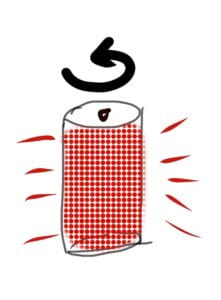Step 1: Build the circuit
In the the first step of the recitation, we had to build the circuit. This was the first time using a microcontroller and stepper motor. At the beginning I was a bit confused about using the microcontroller since I didn’t know which way was up. But after looking carefully, I was able to figure out the part with the semicircle was the top part. Because of the circuit diagram, connecting the wires was straightforward and there weren’t any challenges that I encountered.
After connecting the wires and uploading the code, the stepper motor started to rotate. I did mess around with the speed to see how fast the motor could spin. It was pretty cool.
Step 2: Build a cardboard mechanism!
In the second step, we had to build a cardboard mechanism. This part was done mostly by Jessie, my recitation partner. She cut the cardboard according to the outline. She did a very good job. After cutting the cardboard, she used the hot glue gun to stick the different cardboard parts together. It all came together without any problems. After the cardboard mechanism was done, we connected it to the stepper motor and then the arm part of the cardboard started to move. It was fascinating the see the cardboard move due to the stepper motor.
Step 3: Personalize it
In Step 3, we had to connect the end of the moving cardboard arm to something. Jessie said she wanted to have a cute animal so she drew dog from her WeChat profile. She outlined the drawing of the dog with a piece of cardboard with a pencil first, and then traced it with a marker. Afterwards, she cut the cardboard and we glued it to the end of the moving arm.
Additional Questions
Question 1:
‘Waves’ by Daniel Palacios Jimenez is an interesting art installation since it allows viewers to see the wave oscillations (which are usually invisible) by using a rope. The visualization of waves is fascinating since there are many different types of waves that can be created. Similar to the project that we worked on, his project also uses actuators since it requires motors to rotate very quickly to create the moving oscillations. I think the artist probably selected those specific actuators by trying to create the waves using his hands and moving a piece of rope around. After he was able to distinguish which motion creates the waves, he had to pick a motor which would be able to simulate that motion.
Question 2:
An idea I would be interested in creating for my midterm is a way to visualize interactions with the invisible biology in humans. I would have a Neopixel LED lights that would blink according to a person’s heartbeat. Additionally, there would be a temperature sensor on top of the cylinder that the Neopixel LED is wrapped around. When a person puts their hand on top of the sensor, according to their temperature, the whole cylinder would rotate depending on the temperature. The hotter their temperature, the faster the cylinder would rotate. The stepper motor would be connected to the bottom of the cylinder to rotate the whole cylinder. Using a motor is different that using an animation because movement occurs in a 3D plane while an animation occurs in a 2D plane. Additionally, the motor also gives physical feedback while animation can only return visual feedback.

Materials: Stepper Motor, Neopixel, Cardboard, IR Temperature Sensor. Heartbeat Sensor